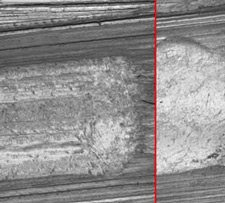Home | Glossary | Resources | Help | Contact Us | Course Map
Archival Notice
This is an archive page that is no longer being updated. It may contain outdated information and links may no longer function as originally intended.
AFTE Theory of Identification
In 1985, the AFTE Criteria for Identification Committee formalized the Theory of Identification as it Relates to Toolmarks. This theory articulates three principles that provide the conceptual basis for comparing fired bullets (and other toolmarked items). Class and individual characteristics provide the physical basis for the microscopic comparison.
For the purpose of this module, consider any use of the word tool as a reference to the rifled interior of a barrel and any use of the term toolmark as a reference to the impressions on a fired bullet.
The three principles of the AFTE Theory of Identification as it Relates to Toolmarks are:
- The theory of identification as it pertains to the comparison of toolmarks enables opinions of common origin to be made when the unique surface contours of two toolmarks are in sufficient agreement.
- This sufficient agreement is related to the significant duplication of random toolmarks as evidenced by the correspondence of a pattern or combination of patterns of surface contours. Significance is determined by the comparative examination of two or more sets of surface contour patterns comprised of individual peaks, ridges and furrows. Specifically, the relative height or depth, width, curvature and spatial relationship of the individual peaks, ridges and furrows within one set of surface contours are defined and compared to the corresponding features in the second set of surface contours. Agreement is significant when it exceeds the best agreement demonstrated between toolmarks known to have been produced by different tools and is consistent with agreement demonstrated by toolmarks known to have been produced by the same tool. The statement that sufficient agreement exists between two toolmarks means that the agreement is of a quantity and quality that the likelihood another tool could have made the mark is so remote as to be considered a practical impossibility.
- Currently the interpretation of individualization/identification is subjective in nature, founded on scientific principles and based on the examiners training and experience.
Sufficient Agreement and
Best Known Nonmatch
The second of the three principles of the AFTE Theory of Identification indicates that the degree of correspondence which must be exceeded to constitute sufficient agreement for an identification is the best known non-match (by each individual examiner) to have been produced by different tools. Ideally, the examiner would gain experience in this during their initial training period rather than when they begin to perform actual examinations on their own.
The third principle of the AFTE Theory of Identification indicates that although founded on the scientific method and reproducibility of results, the interpretation is subjective in nature. As a quality measure,it is the policy of most laboratories that a second qualified examiner verify thescientific findings of the first examiner.
Ultimately, sufficient agreement is the product of the individual examiners training, skills, and experience in
- recognizing corresponding patterns of matching striations,
- recognizing corresponding patterns within impressed toolmarks,
- determining the best known non-match in their personal experience,
- comparing striated and impressed toolmarks.
It is incumbent on each examiner to rely on their training and experience to identify and to be able to articulate the process used to determine sufficient agreement and best known nonmatch.
Additional Online Courses
- What Every First Responding Officer Should Know About DNA Evidence
- Collecting DNA Evidence at Property Crime Scenes
- DNA – A Prosecutor’s Practice Notebook
- Crime Scene and DNA Basics
- Laboratory Safety Programs
- DNA Amplification
- Population Genetics and Statistics
- Non-STR DNA Markers: SNPs, Y-STRs, LCN and mtDNA
- Firearms Examiner Training
- Forensic DNA Education for Law Enforcement Decisionmakers
- What Every Investigator and Evidence Technician Should Know About DNA Evidence
- Principles of Forensic DNA for Officers of the Court
- Law 101: Legal Guide for the Forensic Expert
- Laboratory Orientation and Testing of Body Fluids and Tissues
- DNA Extraction and Quantitation
- STR Data Analysis and Interpretation
- Communication Skills, Report Writing, and Courtroom Testimony
- Español for Law Enforcement
- Amplified DNA Product Separation for Forensic Analysts



